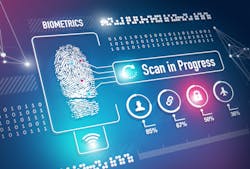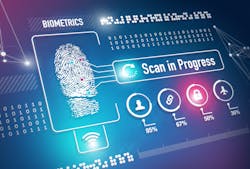Biometrics are here to stay long after the pandemic
The COVID-19 pandemic has had far-reaching impacts on all our daily lives. Travel, events and workplaces have all been significantly impacted by the virus, throwing many peoples’ lives out of balance, and making people more aware than ever of how germs are spread. Given all these changes and trends a new trend has emerged: touchless technology. With COVID impacting so many aspects of our day-to-day lives, there has been a huge surge in demand for technologies that can accommodate both digital and physical access to locations and information without increasing face time with other individuals or spreading germs.
With the increasing need for touchless authentication methods comes the question of how best to meet these demands effectively. Enter biometric technology. Biometrics uses a person’s unique physical characteristics to authenticate their identity quickly and accurately. They are already being incorporated into touchless solutions around the world too, from airport security to workplace access. Thanks to their convenience, speed and security, biometrics are an ideal solution to both addresses today’s COVID-related touchless applications and many others beyond.
Why Biometrics?
The immediate benefit of biometrics as they pertain to the pandemic is that they can effectively reduce or eliminate shared touchpoints. Shared touchpoints are items or locations, or access points used by many different individuals, such as a security kiosk or tablet. With so many different people touching the same devices, the spread of germs is more easily facilitated between individuals, increasing the risk of transmission.Biometric technology effectively eliminates the need for touching screens, devices or entry points to identify and authenticate individuals. Today’s biometric solutions perform face, voice or iris recognition without the press of a button, allowing for the quick passage of authorized individuals while reducing germ spread. Additionally, biometric authentication processes take only seconds to complete, increasing pass-through and helping to maintain social distancing.
Contemporary biometric solutions also directly address the ever-increasing threat of password-based authentication methods. With data breaches and identity theft on the rise globally, passwords have been shown to be a far less effective security mechanism than in the past. Hackers have grown extremely proficient at stealing or guessing passwords, and the need for a more secure alternative has never been greater.
Biometrics solves the problem presented by fraud-prone passwords by relying on what you are—your unique physical characteristics—instead of something you have or know, such as a password or keycard. With a high level of accuracy, and liveness solutions built in to prevent malicious parties from using masks, photos, or video presentations, biometrics serve as a much greater security mechanism than contemporary methods used today.
Additionally, biometrics can leverage the cameras and microphones in today’s smartphones and tablets, allowing its technology to be used virtually anywhere and for many different applications in the field. For example, financial institutions and companies can incorporate biometrics into remote access solutions, securely permitting customers and employees access to their accounts and assets without the need to travel to a branch or office.
Biometric Applications Today
Chances are that by now you’ve either unlocked your smartphone using facial recognition or seen someone else perform the process. This is but one of the many applications for biometrics in use today. Biometrics serve as a key component of many trusted transactions, whether they be unlocking your personal smartphone or accessing your financial accounts remotely or gaining access in general.
Generally speaking, trusted transactions are any process by which a person must be authenticated or identified for secure access to goods, services, accounts, or more. They require a level of trust between the user and provider so that both parties can be assured that only the right individuals can be granted access. In order to achieve this level of trust, a user must first be enrolled in the system. This process establishes who the authorized party is, and when it comes to biometrics, records the person’s physical characteristics for future retrieval. Once enrollment is completed, the user would then be identified and subsequently authorized to proceed. Biometrics performs this process by matching a person’s face, voice, or iris to the information already on file, first identifying them as the right individual, and then authorizing them for access.
Going back to the smartphone example, in order to access your phone via facial recognition, you must have already enrolled yourself in the system, typically when first using your device. Without that first step, subsequent authentication would not be possible. The proliferation of facial recognition in smartphones has also driven home how increasingly comfortable the general population has become in regard to using the technology, opening up the door for many other applications already in use today, including financial account access, visitor management solutions, medical recordkeeping, travel checkpoints and large event access.
Where You Can Expect to See Biometrics in the Future
While biometrics have definitely seen an increased rate of adoption in applications designed to lower virus transmission rates in highly trafficked areas and keep people safe from COVID, they are increasingly being seen as an essential way to increase security and convenience for trusted transactions across the board.
Travel is one industry that has quickly adopted biometrics, not just for COVID-19, but for increased security and passenger convenience. The passenger check-in process in airports around the world is beginning to adopt facial recognition to process travelers more quickly and securely. Similarly, bag-drop procedures are seeing a biometric overhaul to move passengers through quickly and safely, particularly in busy and congested airports where crowding is a problem. Global Entry procedures for international travelers have incorporated biometrics for several years to expedite immigration queues and to ensure the authenticity of the traveler’s identity.
Large events and venues are also turning to biometrics to address the problem of overcrowding, disease transmission and secure access. One recent example involves the 2020 Tokyo Olympics, which rolled out facial recognition technology to help manage crowds, facilitate contactless transactions, and to provide better security for the event overall. Many other large venues and sporting events are beginning to incorporate biometrics into their workflows to achieve these same goals.
With so many offices closed to the pandemic, visitor management solutions have also been building biometrics into their processes to increase security and permit workplace access only to authorized individuals. Instead of speaking to a person at the front desk or typing your information into a kiosk or tablet, authorized visitors can simply present their face or voice to a smart device for quick, secure access to the building.
This is just a start too. With these use cases already in play across so many industries around the globe, it stands to reason that biometric technology will continue to serve similar purposes in these industries and more in the future. Whether for patient records access in healthcare, remote employee onboarding for Human Resources, or international border security solutions, biometrics are here to stay.
An Everyday Solution for Trusted Transactions
With so many impactful benefits, and a wide variety of available use cases, biometrics stand poised to be an everyday staple of our future. With a higher degree of security than conventional methods, a high level of speed and convenience for users, and the built-in capacity for touchless solutions, biometric technology will continue to be a key component of any trusted transaction, providing an enormous benefit to businesses, governments and consumers alike.
About the author: Robert M. Mungovan has over 20 years of experience with Aware. Prior to his current role as Chief Commercial Officer, Mungovan served as Aware’s Vice President of Biometrics and as the Sales and Marketing Manager of Biometrics and Imaging. Before joining Aware, he held positions in several small companies whose focus was digital imaging and machine vision. His passion of working with customers led him on a gradual path from engineering to sales.Mungovan’s first responsibility at Aware was to sell and market an Aware-developed technology for fingerprint image processing. From that initial responsibility, he has played an instrumental role in the establishment of Aware as a premier standalone American biometric product company.
About the Author



